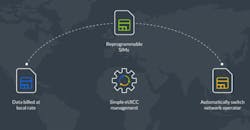Arm’s Pelion Connectivity Management 2.0 system is a cloud-based service designed to manage millions of IoT devices. The platform supports many communication subsystems, including LPWAN as well as 3G, 4G, and LTE cellular where SIM (Subscriber Identity Module) equipped devices are being used. 5G is on the horizon. Arm supports over 600 networks in over 200 countries. Pelion is significant because it can manage devices across country and cellular boundaries (Fig. 1).
1. Pelion provides simplified billing even when devices go beyond country and cellular boundaries.
It supports the latest eUICC (Embedded Universal Integrated Circuit Card) standard, also known as eSIM. This new incarnation targets mobile network operators (MNOs) such as NOS, Portugal’s leading MNO, which is taking advantage of Pelion.
Users can easily create rules and applications to manage IoT devices. Pelion provides a hierarchical, multi-tenant support system that allows Arm’s customers to provide the same support to their customers with the same features and management support. These can be branded by Arm’s customers while providing a common billing and management system. The hierarchy can be many levels deep, so an IoT device could be passed from one customer to another with additional support and services included along the way.
Pelion also supports the protocol stack found on the IoT devices. It handles network security; there’s an API for devices as well as in the cloud. Real-time triggers can be used to adapt IoT devices in the field (Fig. 2). This helps to reduce communication and support costs.
2. Pelion supports real-time triggers that can easily control or disable devices based on a variety of easily configurable rules.
The eUICC support is part of the API mix. It can be used to switch eSIMs from one network to another. This makes it easy to roll out changes to devices that may be managed by different services due to their location. The system can also assist in remotely troubleshooting multiple eUICC SIMs.



